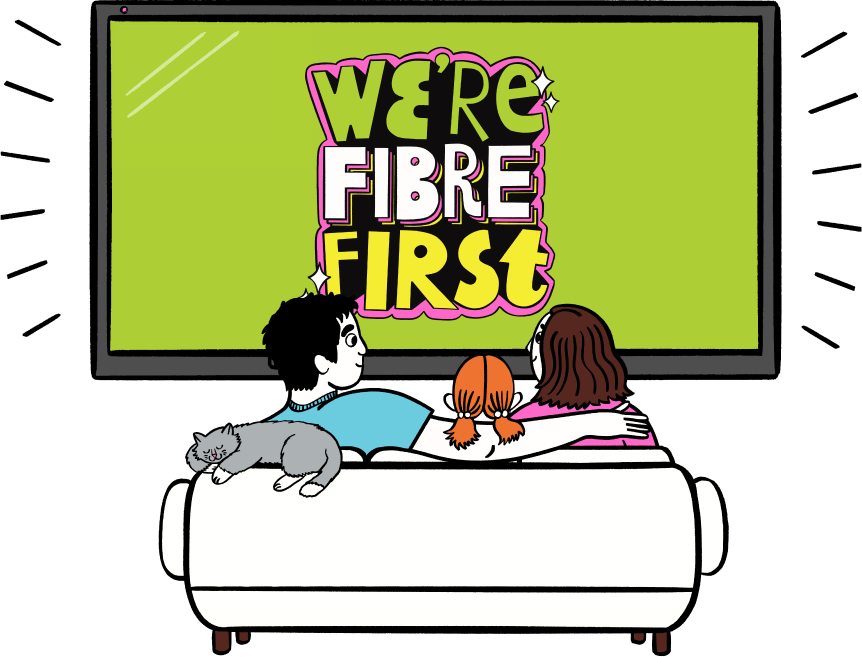
WE'RE THE FIBRE BROADBAND POWER BEHIND

Super-Fast
Unlike copper-wire broadband, our 100% fibre network provides superfast speeds of up to 2Gbps for Residential and up to 10Gbps for Business and an infrastructure designed to support even faster in the future.

Super-Flexible
Unlike copper-wire broadband, our 100% fibre broadband gives you consistently fast speeds—even when multiple devices are connected.

Super-Reliable
Unlike copper-wire broadband, our 100% fibre network ensures 99.99% uptime, so you can rely on uninterrupted access to the digital world.*

Got some questions?
Award Winning Operator?
SIRO, a leading Irish fibre to the home (FTTH) broadband operator, has won the European Fibre Broadband Operator of the Year 2025.
The Award, which is awarded by the Fibre to the Home Council of Europe, recognises companies who have made a significant contribution to the development of full fibre broadband connectivity across Europe.
What is the difference between Copper & Fibre Broadband?
Fibre to the Home (FTTH) is an access network method that delivers superior speeds of internet connection by using optical fibre that runs directly into the home, building or office. The SIRO network is built using the ESB’s overhead and underground infrastructure, ensuring a fast, reliable and sustainable network.
Fibre-to-the-Cabinet (FTTC) versus Fibre-to-the-Home (FTTH). In an FTTC connection, copper is used for the last piece of the connection (from tens to hundreds of meters) connecting the telephone exchange cabinet on the street and the router in your house. All the speed-of-light goodness of fibre optics is lost during this last stretch, and that’s why FTTC delivers speeds of no more that 100Mbps.
On the other hand, SIRO FTTH network connects 100% fibre optic cables all the way to your home, delivering speeds up to 2000Mbps (2Gb). Fibre is faster, more reliable, and superior to copper in many ways, as it removes all the bottlenecks commonly seen in a copper network. You can connect as many devices as you like, play HD games, watch Netflix and download movies without slowing down your connection.
How can I tell if I’m using Copper Broadband?
The easiest way is to get in touch with your current broadband provider—they’ll be able to tell you. You can also try a quick speed test online. While it doesn’t confirm the type of connection, slower-than-expected speeds might be a sign that you’re on a copper broadband network.
What does 99.99% Reliability Mean?
SIRO’s 100% fibre network is ‘Reliable by Design’ delivering 99.99% uptime to homes across Ireland. That means your internet is available nearly all the time. We track and report our service levels every month to ensure you’re getting the performance you can count on.
SIRO SERVICE AVAILABILITY
| Jul 24 | Aug 24 | Sep 24 | Oct 24 | Nov 24 | Dec 24 | Jan 25 | Feb 25 | Mar 25 | Apr 25 | May 25 | Jun 25 | Jul 25 |
|---|---|---|---|---|---|---|---|---|---|---|---|---|
| 99.999 | 99.996 | 99.998 | 99.999 | 99.998 | 99.999 | 99.998 | 99.999 | 99.999 | 99.998 | 99.999 | 99.999 | 99.999 |
How easily can I switch to SIRO Fibre Broadband?
First step check your Eircode, choose a retailer of your choice, place your order and choose an appointment time that works for you. Some homes may require an installation survey.
What if I don’t have an Eircode?
You can still connect to the SIRO network, but will be limited to those retailers that can do so without an Eircode. Please email your full address to info@siro.ie, and request your Premises ID. This number is unique to your property on our network. We will respond with your Premise ID, and a list of retailers for your area who will be able to accept an order, if you are unable to wait for your Eircode to be issued.
What is the Copper Switch-Off?
Copper switch-off refers to the planned discontinuation of the traditional copper broadband network. Copper is being switched off because it simply can’t meet the demands, of more bandwidth, higher speeds and greater data needs, now placed upon it. The transition will mean that homes and businesses will move to a full fibre network which is faster, more reliable and future proofed for decades to come – full fibre broadband.
Why Does Copper Switch-Off Matter?
It matters because the days of copper broadband are numbered. Ireland’s telecoms regulator, Comreg, has approved the commencement of the copper switch off process. Separately, the European Commission’s Digital Decade strategy aims to ensure that all European households have access to gigabit connectivity by 2030, which practically means replacing outdated copper networks with full fibre (FTTH).
Not only will copper broadband be phased out but a wide range of devices currently dependent on copper will need to be upgraded to be compatible with modern broadband. These include many everyday home and business devices, such as landline phones, house and fire alarms, medical and security monitors, lifts, retail sales terminals or CCTV systems.
When will Copper Switch-Off Happen?
The European Commission has proposed 2030 as the deadline for this transition across the EU, meaning Ireland must also meet this target. It is time to prepare for this change now, to keep everything running smoothly and jump into the fast lane of fibre broadband.
Is fibre connectivity impacted by weather?
Fibre broadband is more weatherproof than copper broadband. “Electronic Communications Networks (ECN) operators have noted that newly built fixed access ECNs that rely on fibre are more resilient than legacy copper ECNs. This is because fibre-based infrastructure is more resilient to water ingress and lightning strikes relative to copper. Fibre overhead lines are exposed to strong winds, however, fibre cables are lighter than the same diameter copper cable. This implies that after copper cable is retired the weight loading on overhead routes and the corresponding damage risks will be reduced which will make the overhead lines less vulnerable to wind damage.”

